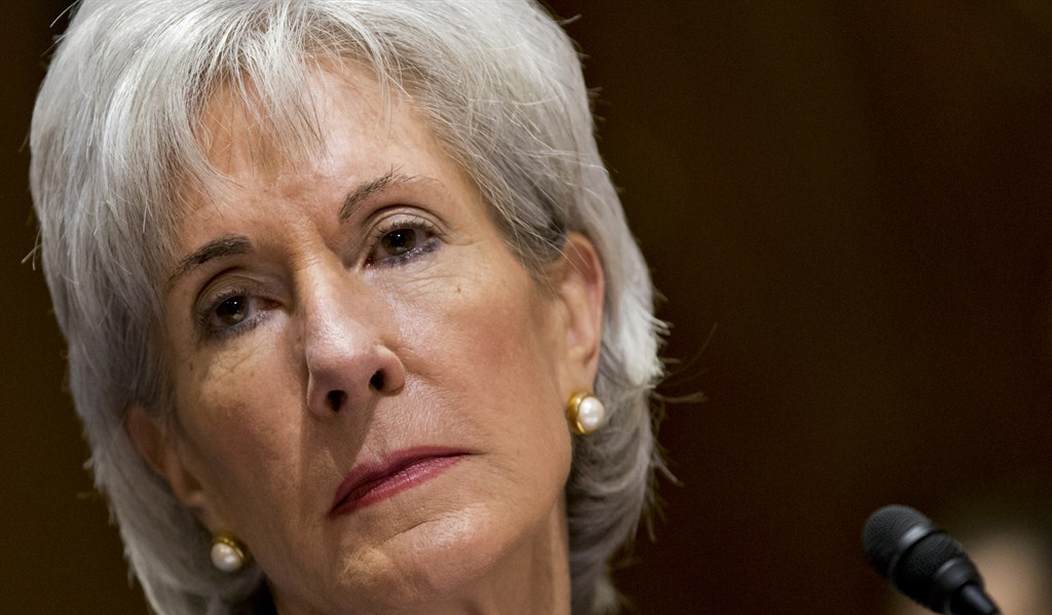As Obamacare's missed deadlines and haphazard, politically-motivated postponements piled up in late 2013, we regularly predicted that the new calendar year would bring more -- not fewer -- headaches for the law's advocates. It's only January 6th, yet 2014's anthology of horror stories is already expanding rapidly. In addition to the baby snafu, the UK Daily Mail reports on angry, untreated consumers walking out of hospital waiting rooms because of logistical disruptions:
Hospital staff in Northern Virginia are turning away sick people on a frigid Thursday morning because they can't determine whether their Obamacare insurance plans are in effect. Patients in a close-in DC suburb who think they've signed up for new insurance plans are struggling to show their December enrollments are in force, and health care administrators aren't taking their word for it. In place of quick service and painless billing, these Virginians are now facing the threat of sticker-shock that comes with bills they can't afford. 'They had no idea if my insurance was active or not!' a coughing Maria Galvez told MailOnline outside the Inova Healthplex facility in the town of Springfield. She was leaving the building without getting a needed chest x-ray. 'The people in there told me that since I didn't have an insurance card, I would be billed for the whole cost of the x-ray,' Galvez said, her young daughter in tow. 'It's not fair – you know, I signed up last week like I was supposed to.' The x-ray's cost, she was told, would likely be more than $500. Galvez said she enrolled in a Carefirst Blue Cross bronze plan at a cost of about $450 per month through healthcare.gov, three days before Christmas. 'No one has sent me a bill,' she said.
That final sentiment is exactly the reason why the administration won't say how many of the 2.1 million Obamacare "enrollees" have actually secured coverage by paying their first month's premiums. Then again, the British paper notes that even if Ms. Galvez's insurance had been fully active in time for her hospital visit, it may not have done her much good because of her plan's high deductible:
Recommended
It's unlikely that a valid insurance card would have changed Galvez' fortunes, however. Her Carefirst plan, identified on the Obamacare website as BlueChoice Plus Bronze, carries a $5,500 per-person deductible for 2014 – an amount she would have to pay out-of-pocket before her coverage would apply to medical expenses. The Inova radiology department wouldn't speak with MailOnline, and Carefirst did not respond to a request for comment. A similar situation frustrated Mary, an African-American small businesswoman who asked MailOnline not to publish her last name. She was leaving the Inova Alexandria Hospital in Alexandria, Virginia with two family members. 'I had chest pains last night, and they took me in the emergency room,' Mary said. 'They told me they were going to admit me, but when I told them I hadn't heard from my insurance company since I signed up, they changed their tune.' She told MailOnline that a nurse advised her that her bill would go up by at least $3,000 if she were admitted for a day, and her doctor told her the decision was up to her.
Welcome to the new regime, America. Meanwhile in Illinois, a surgeon chose to operate on a female patient even though his office couldn't verify whether she was covered by an Obamacare "bronze" plan she and her husband signed up for in mid-December. A receptionist reportedly spent two hours on the phone with the insurance company seeking answers, but got none. The doctor told the Associated Press that many of his patients are experiencing "tremendous uncertainty and anxiety" because of the new law. A 61-year-old Illinois woman with pre-existing conditions had a hard time obtaining coverage because Obamacare's website wouldn't let her pay for her silver plan. She ultimately sorted out the issue, but says she's worried whether the unstable, costly law is viable for the long term: "My biggest concern is, how long is this going to last? How long can our country bear this expense? It’s a benefit for us right now. But I don’t see how it can possibly be sustainable." Reuters reports that White House officials are worried that as more Americans seek medical treatment in the coming weeks, a fresh torrent of negative incidents will bleed into the media. They have ample cause for concern. The Washington Post published a story over the weekend detailing how more than 100,000 Americans who are newly eligible for Medicaid and CHIP aren't covered due to Obamacare "defects:"
More than 100,000 Americans who applied for insurance through HealthCare.gov and were told they are eligible for Medicaid or the Children’s Health Insurance Program (CHIP) remain unenrolled because of lingering software defects in the federal online marketplace, according to federal and state health officials. To try to provide coverage to these people before they seek medical care, the Obama administration has launched a barrage of phone calls in recent days in 21 states, advising those who applied that the quickest route into the programs is to start over at their state’s Medicaid agency. State officials, meanwhile, are racing to cope in various ways — some enrolling people based on imperfect data files they received from Washington, others mailing letters urging eligible people to contact the state to sign up...The situation also offers a glimpse of the technical problems that persist with the computer system underpinning the new federal online insurance marketplace more than a month after the Obama administration announced it had largely been fixed.
To combat this problem, officials are frenetically attempting to contact consumers and urging them to reboot their entire enrollment process. They're also attempting to rely on the garbled and corrupted files that have been fed through Healthcare.gov's back end. Media reports and administration figures pointed to an error rate of somewhere between 25 percent and 33 percent that affected thousands of enrollments in October and November. The White House said that number had been reduced to 10 percent (still horrible) by early December. Ed Morrissey points out that in the case of Medicaid and CHIP error rates, the government's misfires had nothing to do with an inability to adequately sync Healthcare.gov's back end to private insurers' online systems. Those are the "834 errors" we've written about extensively. No, these are instances of the federal government failing to coordinate its new online system with existing government databases. Bear in mind that the administration had more than three years and well over $1 billion to implement a functional system, yet the various sites are still rife with bugs and mistakes. And those errors aren't just theoretical anymore. They're impacting real people -- in this case, 100,000-plus low-income Americans. In fairness, who could have predicted that the federal bureaucracy was ill-suited to execute a mind-bendingly complex technical lift involving countless moving parts? Answer: Here's one person who did.
























Join the conversation as a VIP Member